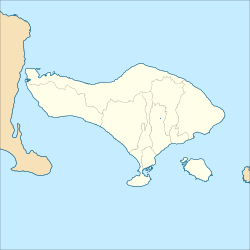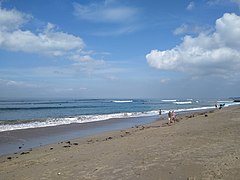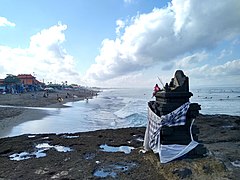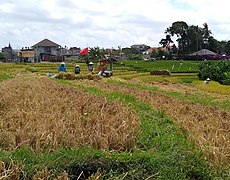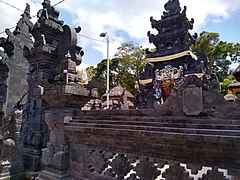Canggu
Canggu | |
|---|---|
Village | |
 A street in Canggu | |
| Coordinates: 8°39′21″S 115°08′3″E / 8.65583°S 115.13417°E | |
| Country | |
| Province | Bali |
Canggu (Indonesian pronunciation: [ˈt͡ʃaŋɡu]) is a coastal village with a 10 km-long beach on the south-west coast of Bali, Indonesia.
Location
Canggu is in North Kuta district, in Badung Regency.[1] It lies approximately 10 kilometers north-west of Kuta and 12 km north-west of Denpasar.[2]
Main streets, temples and beaches
The main Canggu streets are Jalan Raya Canggu, Jalan Batu Bolong, Jalan Padang Linjong, Jalan Batu Mejan and Jalan Tanah Barak. Along Jalan Batu Bolong you find the temple of the dead, Pura Merajapati, and the Pipitan Cemetery. Along the beach there are two main temples, Pura Batu Bolong and Pura Batu Mejan, both hundreds of years old, built upon the initiative of Dang Hyang Nirartha.
Canggu has nine beaches that serve as its tourist magnets: Canggu Beach, Echo Beach, Batu Bolong Beach, Kayu Putih Beach, Pererenan Beach, Berawa Beach, Seseh Beach, Mengening Beach, and Nelayan Beach.[3] Echo Beach (also known as Mejan Stone Beach) is the westernmost beach in Canggu just before Perenenan.[2] Batu Bolong Beach is well known, situated next to a temple.. At the end of the road it leads to many bars and restaurants. The quieter Nelayan Beach is the last beach before Berawa Beach.
Tourism and development
According to Bunyamin et al. 2023, tourism in Canggu started with Canggu village and the Canggu surf community jointly hosting an international surfing event in 1990.[3] In those days, the Canggu area had scenic views of paddy fields and coconut groves.[4][5] But after Kuta, Legian and Seminyak,[6] Canggu has become one of the most popular destinations in Bali since the beginning of the 2020.[7] In 2023–2024, Canggu is feverishly transforming into a highly urbanised zone[6] and the current rapid development has by now replaced the rice fields, farmland and natural open spaces[8][9][a] with private villas,[4] hotels and diverse constructions aimed at tourists.[6][12] As of 2023, about 324 hotels and other lodgings are registered in Canggu Village[3] and high market brands have started moving in, such as Hugo Boss diversifying into the tourism industry by taking over a luxury rental villa in 2024.[6] There is a huge increase in restaurants, bars, and places to hang out.[7] Housing speculations are rife, such housing being built with the sole tourism investment industry in mind, for example the Las Casas and Blacksand villa projects.[13]
One project in particular has gathered much controversy: the five-star and — originally — seven-floor Taryan Dragon Resort & Residence, on more than 1 hectare right along Seseh beach[14][15] in Cemagi, next to Canggu.[16]
[b]
Following a mediatised protest campaign and petition,[14] its developer halted the project in September 2023[18] and proceeded with what he had not done as yet: meet and consult with the community leaders.
The Ukrainian company took some engagements towards the community and the surrounding area.[c]
From around September 15, it took hardly six weeks for the local community leaders to warmly welcome the new Taryan project.[17]
By the following November 3, many of them and the Taryan Dragon Resort & Residence team took part in a traditional Balinese Ngeruak[d] ceremony.[17][19] This was immediately followed by a meeting at Adat Seseh in Cemagi that gathered owners’ representatives and shareholders of the Taryan Group, the local Balinese architects and construction company, and more than 100 community figures. A berita acara officiation or letter of support was signed by all parties and validated the project.[17] The final design was presented in December 2023,[17]
with work on the ground due to start early January 2024,[19] aiming for completion in 2026.[15][17][e]
Then, as of May 2024, Taryan Group (founder and owner Artur Mkhitaryan) associated with Anantara Hotel Group (owned by Minor International, CEO Dillip Rajakarier) and the Taryan Dragon project is relabelled the Anantara Dragon Seseh Bali Resort. When it opens, it will be the fourth venue owned by Anantara Hotel Group who already possesses Avant Seminyak Bali Resort and Anantara Uluwatu Bali Resort, along with Anantara Ubud Bali Resort due to open in September 2024.[6]
- Water problem
Mass tourism industry has become the largest consumer of water, consuming 65% of freshwater in Bali and having lowered the island's water table by some 60%.[20] Canggu is in North Bandung, where 64% of households are connected to the water mains (piped water). But this piped water is very unreliable, in particular during the dry season; therefore all tourism-related venues (hotels, villas, restaurants, laundries, spas etc.), and many households, have wells with electric pumps (bored wells or sumur bor) even if they are connected to the piped water system; and nearly all these wells are 60 m deep, which means they are deep enough to bring salt water intrusion - and irreversible pollution[21] but also a falling water table, land subsidence and deteriorating water quality.[22] Hand dug wells, usually no more than 12 m deep, now dry up in season.[23] In theory all commercial ventures must have a well permit, except for warung or little food stalls; but many large restaurants are now called warung (such as Warung Made, one of Bali's premier restaurants with several branches). Another handy misuse of vocabulary occurs with the word "villa", supposedly a private house and as such paying a lower premium for water than even a simple guest house; but the Bali Villa Association asserts that "Anything can be a villa", and that includes tourism accommodation with 70 rooms, each with their own swimming pools.[24]
Another problem is that of coordination: the responsibility for clean water in Bali falls to eleven different government departments (in 2012), each of which represented at the three levels of the Indonesian government system: National, Provincial and Regency. This results in plenty of rules but nobody taking responsibility to enforce any of them.[23] Moreover, each department competes with the others for ownership (and potential funds) of all projects, thus further impeding proper resources management.[23]
- Infrastructures inadequacy
The infrastructure was adequate for settlement activities, but has not followed the tourism development and cannot deal with the growth of tourism activities.[25] Examples of this are the increased volume of waste generated by the rising number of visitors, leading to occasional waste pileups;[26] or the roads, inadequate for the massive increase of tourism activities, with the consequence that the quality of the local road surfaces have deteriorated by 53.16% in 2023. Drainage provision for waste disposal is insufficient by 52.77% (in 2023).[27] And waste infrastructure and facilities is 100% inadequate (in 2023).[28]
Seminyak's Petitenget Beach (next door to Canggu) and Canggu's Batu Bolong Beach seawaters were found contaminated with Escherichia coli in 2022.[29]
For all these reasons, Canggu has made it to the list of "Slum and Blighted Areas in Badung Regency", with a decline in quality affecting 64.37 ha — the largest area experiencing such a decline.[27]
Nearby Uluwatu has become the next tourism development target, with tourists splitting their visits between Canggu and Uluwatu.[13]
- Tourism revenue leakage
The increased number of accommodations brings higher regional revenue, Gross regional domestic product (PDRB), and some income for the local community[26] But the local population mostly owns small businesses with low margins who face the strongest competition, such as budget accommodations and tour operators. The large proportion of ownership by outsiders, in conjunction with these outsiders owning the businesses with the highest profits, presents a significant source for financial leakage.[30]
- Increased costs of living
The costs of living has become more expensive due to tourism,[31] including housing, food, goods, and such services as healthcare.[32]
- Increased nuisances
This includes the aforementioned pollution, sewage problems etc. as exposed above. It also includes increased noise and population density. As a result, the condition of Canggu Village becomes less conducive for settlement purposes and, at the same time, for supporting tourism activities.[33] Residents consider that such touristic area as Canggu is no longer a good place to raise a family: including and beyond the stated infrastructure problems, there is also that of alcohol abuse from tourists, which brings various troubles and a level of insecurity.[34]
- On culture
The locals feel that their own culture in Canggu had started to become influenced by tourists. There is also mention that religion and traditions are commercialised to earn money from tourists.[35] In Canggu, where tourism is not based on local culture, the locals do not feel included in the tourism development process; this to be compared to Ubud, another rising tourism area but this one based mostly on local culture and where the locals have a more positive feeling towards tourism, due in part to that they feel more involved in the development process.[36]
Traffic
While traffic is quite heavy within Canggu, the main road (Jalan Raya Canggu) is notoriously jammed with traffic. In order to avoid going north-east to the main road, many riders choose to take the infamous Canggu-Berawa shortcut or Canggu shortcut (Jalan Anggrek), which connects Canggu to Seminyak. It is also often congested and restricted due to its narrowness, even though cars can only travel one way, from Canggu to Berawa.[37][38][39]
Surfing
Canggu has gained popularity among surfers as a longboard-friendly surf spot, one of the few on the island. Three main strips have developed for tourists - surfers and non-surfers alike.[40] The spotlight on the area as a surf destination has been helped along by the presence of Deus Ex Machina's Bali outpost, the Deus Temple of Enthusiasm, and its annual contests that focus on classic single-fin long-boarding.[41]
Gallery
- Canggu
- A beach
- A beach
- Harvesting rice (2019)
- A terraced field (2019)
- Pura Batu Mejan
Notes and references
Notes
- ^ One of the reasons that bring farmers to sell their fields is that the land is taxed according to its saleable value. So all fields that stand next to a tourism development are hit with unaffordable land taxes set at the same value as that development - and are further impaired by the amount of water drained up for tourists.[10]
Another related problem is that most of Canggu is designated Green Belt, but this is largely ignored and development has continued unabated.[10] The law states that no building should occupy more than 40% of any plot (the remaining 60% should be garden); but many count the swimming pool as "garden".[11] - ^ The Taryan Dragon Resort & Residence project had earned Ukrainian company Taryan Towers a world-class win of the International Property Awards in the category of “Best Residential High-Rise Development 2021 Nomination”.[17]
- ^ The development would have to respect Balinese and Indonesian traditions and regulations, to focus on integrating cultural and religious activities, to not feature noisy venues like beach clubs or karaoke bars, to ensure that 40% of the workforce will be local people,[19] to collaborate with local communities in the field of tourism education and training,[15] and to involve local security (pecalang) for a smooth process of development and operations.[19] Additionally, Taryan Dragon would endeavour to assess and provide assistance for Seseh’s own village (desa) projects, including a comprehensive road reconstruction project, better lighting, smoother surfaces and marked laneways[17] — thus giving the hotel a sleeker environment image. Some environmentally-responsible commitments were made too: the number of floors has been reduced, building sections reduced and reconfigured, the beach club changed into a beach lounge,[19] facades covered with greenery,[15] more Balinese materials integrated,[19] as well as the use of local eco-materials and recycled plastic through an agreement with an Indonesian recycled furniture company.[17]
- ^ The Ngeruak is a land blessing ceremony that gives thanks to the land and asks permission to change the landscape.[19]
- ^ The project as presented in December 2023 was for 216 rooms and suites, a beach lounge, three swimming pools and three dining outlets including a Japanese restaurant and poolside bar.[6]
References
- ^ "Canggu". m.nomor.net. Retrieved 2024-06-04.
- ^ a b "Canggu, map". google.com/maps.
- ^ a b c Bunyamin, A. Siti Namirah; Swasto, Deva fosterharoldas; Fresiani, Anggun; Fajar, Edy Al (2023). "The Impact of tourism activities on the infrastructure of Canggu village settlements reviewed from the perspective of 4A principle" (PDF). E3S Web of Conferences (The "4A principle": Attraction, Amenity, Ancillary, Accessibility). 468 (468). Universitas Gadjah Mada, Yogyakarta, Indonesia: 1–7 (see p. 3). Bibcode:2023E3SWC.46810010B. doi:10.1051/e3sconf/202346810010. Retrieved 2024-06-28.
- ^ a b "Canggu Living". ezytraveltrip.com. 10 September 2022. Retrieved 22 September 2022.
- ^ Bunyamin et al. 2023.
- ^ a b c d e f "Big Name Brands Announce Hotel And Villa Projects In Bali". thebalisun.com. 27 May 2024. Retrieved 2024-06-05.
- ^ a b
Ericson, Maja; Helmer, Filippa; Roos, Jessica (2023). Residents perceptions of tourism in Bali: a comparative field study in Canggu and Ubud (PDF) (Thesis for Bachelor's Degree in Business Administration). University of Borås. p. 4.
{{cite book}}: CS1 maint: location missing publisher (link) - ^ Ericson, Helmer & Roos 2023, p. 27.
- ^ Brigid Delaney (14 March 2019). "Are we killing Bali? I've been deluded thinking there isn't friction with the locals". theguardian.com. Retrieved 2024-06-30.
- ^ a b Cole 2012, p. 1233.
- ^ Cole 2012, p. 1232.
- ^ Ericson, Helmer & Roos 2023, p. 15.
- ^ a b "Bali's Q1 Tourism Update and Its Impact on Real Estate Investment". linkedin.com. 25 April 2024. Retrieved 2024-06-30.
- ^ a b Anasya Dufana (15 September 2023). "Controversial Seven-Floor Project Sparks Heated Debate and protest in Bali's Seseh beach". socialexpat.net. Retrieved 2024-06-03.
- ^ a b c d Rosihan Anwar (28 November 2023). "Collaboration, The Taryan Dragon Resort & Residence Builds Premium Apartments in Seseh-Bali". radarbali-jawapos-com. Retrieved 2024-06-03.
- ^ "Cemagi, map". google.com/maps.
- ^ a b c d e f g h "Taryan Dragon Resort & Residence: A new investment project to Bali is set to break ground in Seseh, Bali, Indonesia, at the end of April, 2024". theyakmag.com. 6 December 2023. Retrieved 2024-06-03.
- ^ Anasya Dufana (19 September 2023). "Victory for Seseh Beach: Taryan Dragon project officially cancelled amidst collaborative efforts". socialexpat.net. Retrieved 2024-06-03.
- ^ a b c d e f g "Construction To Start On Huge Resort In Bali's Seseh Despite Initial Community Complaints". thebalisun.com. 30 November 2023. Retrieved 2024-06-03.
- ^ Huang, Hao (July 2020). "Nature and the Spirit: Ritual, Environment, and the Subak in Bali". EnviroLab Asia. 3 (2): 1–22 (see p. 14). doi:10.5642/envirolabasia.20200401.02. Retrieved 2024-05-12.
- ^ Cole, Stroma (2012). "A political ecology of water equity and tourism: A Case Study From Bali". Annals of Tourism Research. 39 (2): 1221–1241 (see p. 1229–1230). doi:10.1016/j.annals.2012.01.003. Retrieved 2024-06-30.
- ^ Cole 2012, p. 1234.
- ^ a b c Cole 2012, p. 1230.
- ^ Cole 2012, p. 1231.
- ^ Bunyamin et al. 2023, p. 4-5.
- ^ a b Bunyamin et al. 2023, p. 4.
- ^ a b Bunyamin et al. 2023, p. 6.
- ^ Bunyamin et al. 2023, p. 7.
- ^ "Testing Finds Dangerous Bacteria At Bali's Most Popular Beaches". thebalisun.com. 26 June 2023. Retrieved 2024-06-30.
- ^ Remmer, Stefanie; Achmad, Ibnu (April 2017). Tourism Impacts in Labuan Bajo (PDF). Swisscontact WISATA. p. 16.
- ^ Ericson, Helmer & Roos 2023, p. 22.
- ^ Victoria Heinz (10 July 2023). "Negative Impacts of Tourism in Bali: A Comprehensive Guide". unsustainablemagazine.com. Retrieved 2024-06-30.
- ^ Bunyamin et al. 2023, p. 5.
- ^ Ericson, Helmer & Roos 2023, p. 26.
- ^ Ericson, Helmer & Roos 2023, p. 23.
- ^ Ericson, Helmer & Roos 2023, p. 25-26.
- ^ "Local residents put up banner prohibiting cars from entering narrow Canggu Shortcut". coconuts.co. 10 February 2020. Retrieved 1 May 2020.
- ^ "Canggu Shortcut – saves you lots of time". balivillaescapes.com.au. 1 February 2023. Retrieved 21 February 2024.
- ^ "The Canggu Cut-Through: Bali's Shortcut to Adventure". beautifulroads.fyi. 14 February 2024. Retrieved 21 February 2024.
- ^ "Canggu travel". lonelyplanet.com.
- ^ "Deus Ex Machina® Australia Official Online Store". deuscustoms.com.
External links
 Canggu travel guide from Wikivoyage
Canggu travel guide from Wikivoyage
8°39′21″S 115°08′3″E / 8.65583°S 115.13417°E https://focaljourney.com/things-to-do-in-canggu-city-bali-attractions/

